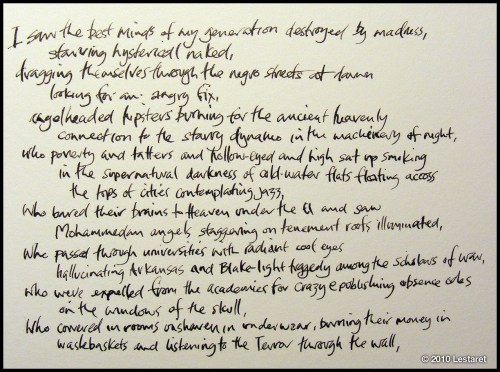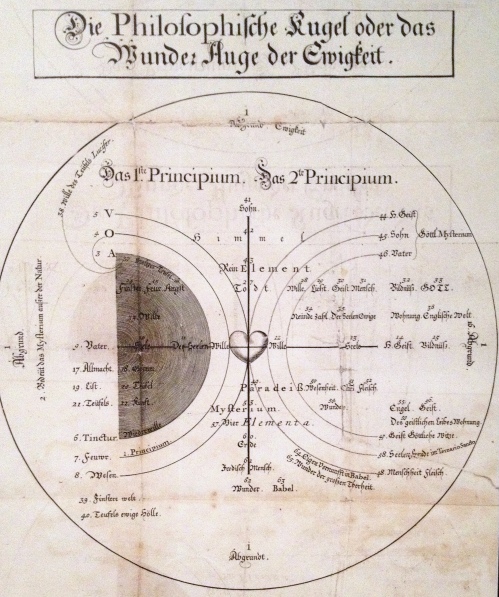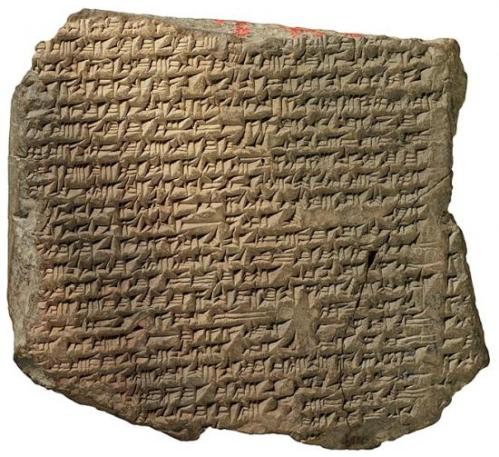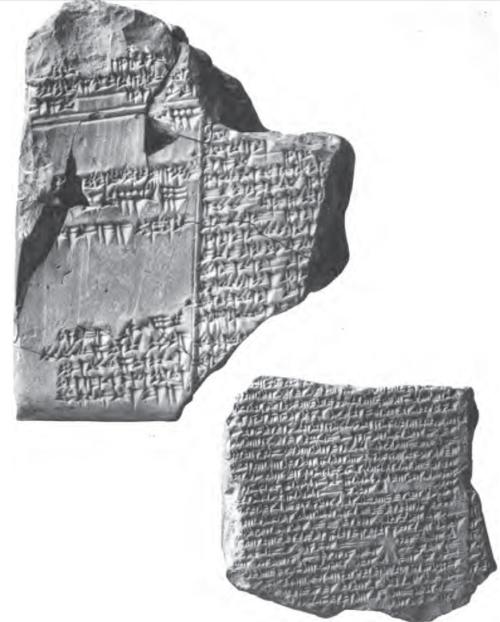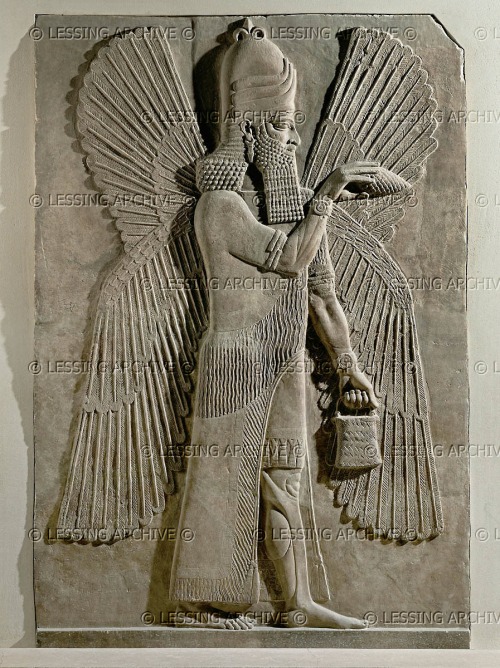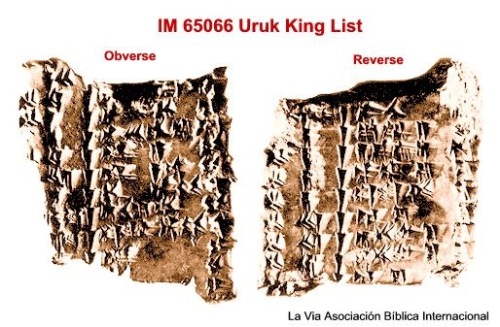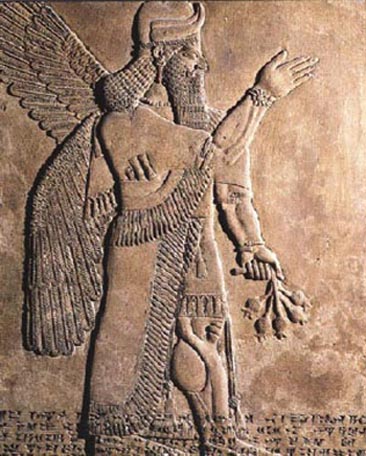“By the term “Rosicrucian linguistics” Ormsby-Lennon (1988) indicates a current of thought prevalent in Germany and England in the seventeenth century, whose influences could still be traced in the proposals for the invention of scientific languages by Dalgarno and Wilkins.
According to Ormsby-Lennon the Rosicrucians derived their notion of magic language from Jacob Böhme‘s theory of signatures.
Böhme, a mystic whose ideas had a great influence on later European culture, was well known in Rosicrucian circles in Germany.
From here, through a series of translations that continued into the eighteenth century, his influence passed into English theosophist culture. Webster, in his Academiarum examen of 1654, observed that the ideas of Böhme were recognized and adopted by the most enlightened confraternity of the Rosy Cross (pp. 26-7).
Böhme drew, in his turn, on Paracelsus‘ conviction that every natural element bore a sign that revealed its special occult powers, which in its turn recalls the tradition of physiognomics: powers were “signed” or marked in the forms and figures of all material things in the same way as the qualities of a man were revealed by the form of his face.
Nature had created nothing that failed to manifest its internal qualities through external signs, because the external forms of objects were, so to speak, nothing more than the result of the working of these same internal qualities.
Knowing this, humanity was on the way to discovering the essence of essences, that is to say, “the Language of Nature, in which each thing speaks of its particular properties,” (Signatura rerum, 1662, I).
In the writings of Böhme, however, the idea of signatures did not follow the previous magical tradition, but rather evolved as a mystical metaphor expressing the ideal of an unending search for the traces of the divine force which pervades the whole creation.
For Böhme, the mystic way started with a contemplation of simple, material objects which, at a certain point, might, as it were, burst into flames in an epiphany which revealed the true nature of the invisible.
His own vocation had been decided when, being still a young man, gazing at a tin pot struck by the rays of the sun, he was suddenly vouchsafed a vision that became, like Borge’s Alef, a privileged moment in which the light of God present in all things suddenly disclosed itself.
Böhme spoke of the speech of nature, or Natursprache, in his Mysterium Magnum of 1623; he described it as a “sensual speech” (“sensualische Sprache“) which was both “natural” and “essential.” It was the speech of all creation, the speech which Adam had used to name material things:
“During the time when all peoples spoke the same language, everyone naturally understood each other. When they no longer wished to use the sensual speech, however, they lost this proper understanding because they transferred the spirit of sensual speech into a crudely external form. [ . . . ]
Today, while the birds of the air and the beasts of the forests may still, each according to their own qualities, understand each other, not one of us understands the sensual speech any longer.
Let man therefore be aware of that from which he has excluded himself and that with which, moreover, one day, he will once again be born again, though no longer here on earth, but in another, spiritual world.
Spirits speak only to each other in sensual speech, and have no need for any other form of speech, because this is the Speech of Nature.” (Sämmtliche werke, Leipzig, 1922: V, 261-2).
In this passage, it is evident that, for Böhme, such Natursprache was no longer simply the language of signatures. When the spirits of the other world hold converse with one another, it is obvious that they use something more than natural signs.
It seems that the sensual speech was the same in which Adam named the animals and the same as the language given the apostles at Pentecost, an “open sensual speech” that comprehended all other languages.
Although this gift was lost in the confusion of Babel, it will, one day, return to us when the time is ripe, and we will be ready to converse with God. It seems evident that what Böhme is here describing is the language of glossolalic enthusiasm, or the so-called language of tongues.
Böhme’s notion of sensual speech seems very similar to Reuchlin‘s notion of the language of Adam alluded to in his De verbo mirifico (II, 6); this was a language manifested as a “simplex sermo purus, incorruptus, sanctus, brevis et constans [ . . . ] in quo Deus cum homine, et homines cum angelis locuti perhibentur coram, et non per interpretem, facie ad facie [ . . . ] sicut solet amicus cum amico” (“a simple and pure speech, uncorrupted, holy, brief, and constant, in which God and men, and men and angels could talk in each other’s presence, not through interpretation, but face to face, just as is usual between friends.”)
Or perhaps it was the same as the language of the birds, in which Adam during his sojourn in Eden could converse with (as well as name) every beast of the field, and every fowl of the air. After the Fall, the speech of birds was, once more, revealed to King Solomon, who taught it to the Queen of Sheba. It was a form of speech revealed as well to Apollonius of Tyana (see Ormsby-Lennon 1988: 322-3).
We find a reference to this language of the birds in the chapter entitled “Histoire des oiseaux” in the Empires du Soleil of Cyrano de Bergerac (on Cyrano and language see Erba 1959: 23-5).
In this chapter, the traveller meets a marvelous bird whose tail is green, whose stomach is of an enamel blue, and whose purple head is surmounted by a golden crown. The bird addresses the traveler in a “singing speech” and he, to his amazement, finds that he is able to understand all that the bird has to say.
Nothing the perplexity on the traveler’s face, the bird explains:
“Among you humans there have been those able to speak and understand our Language. There was Apollonius of Tyana, Anaximander, and Aesop, and many others whose names I will not mention as you would not recognize them. Just so, there are to be found among the birds those who can speak and understand your own language. Thus, just as you will encounter birds that do not say a word, others that merely twitter, and others still that can speak, so you may even encounter one of the most perfect birds of all–those who can use all idioms.”
Was it then the practice of speaking in tongues that the Rosicrucians had in mind in their manifestos to the learned of Europe? Yet, if this is so, how are we to understand the allusions to a “secret writing . . . . expressed symbolically by numbers and designs?”
Why did they use the terms “characters and letters” when, in this period, these were notions associated with the search for the alphabetic characters capable of expressing the nature of things?
Umberto Eco, The Search for the Perfect Language, translated by James Fentress, Blackwell. Oxford, 1995, pp. 182-5.
